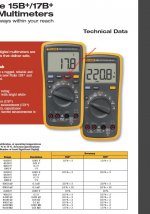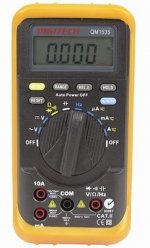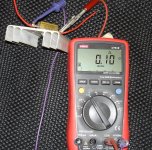I bought a Digitech QM1535 digital multimeter and it served me for 10 years reliably. Lately when reading a straight wire it jumped from 0R to 7R to 21R back to 0R, to 7R, 21R and going through loops like that indefinitely. Checked batteries and they were OK.
I then bought a VICHY DM4070 which went bad after a very short time.
So I searched the forum and took the recommendation and bought a Fluke 15B+. So far it works well but I am not very impressed with its accuracy when measuring lower ohm resistors. It seems to give me some random reading of 0.4R or 0.6R or something from anything between 0R to 1R. My old Digitech QM1535 did a lot better in this before it went bad.
Question:
1. Can I still use the Digitech QM1535 to measure voltages accurately? would the voltage circuit inside the QM1535 be completely independent from the resistor measurement circuit, so the voltage measurement of the QM1535 is still good?
2. Did the digital multimeter go bad because of aging / reliability, or because of misuse? Perhaps occasionally there were voltages on the circuit boards when I measured resistance? Perhaps the resistance meter cannot be used to measure large capacitance when I tried to check if the large capacitor band was sorted?
Thanks.
I then bought a VICHY DM4070 which went bad after a very short time.
So I searched the forum and took the recommendation and bought a Fluke 15B+. So far it works well but I am not very impressed with its accuracy when measuring lower ohm resistors. It seems to give me some random reading of 0.4R or 0.6R or something from anything between 0R to 1R. My old Digitech QM1535 did a lot better in this before it went bad.
Question:
1. Can I still use the Digitech QM1535 to measure voltages accurately? would the voltage circuit inside the QM1535 be completely independent from the resistor measurement circuit, so the voltage measurement of the QM1535 is still good?
2. Did the digital multimeter go bad because of aging / reliability, or because of misuse? Perhaps occasionally there were voltages on the circuit boards when I measured resistance? Perhaps the resistance meter cannot be used to measure large capacitance when I tried to check if the large capacitor band was sorted?
Thanks.
The reason I asked the question is now I need to set the bias current of my MOSFET amp so I want to have a very accurate reading of low voltages.
I use 0.1R source resistor so I am expecting a reading of 8mV. I am wondering if the Fluke 15B would give me accurate reading on that low voltage. Perhaps the QM1535 would give me more accurate reading?
I use 0.1R source resistor so I am expecting a reading of 8mV. I am wondering if the Fluke 15B would give me accurate reading on that low voltage. Perhaps the QM1535 would give me more accurate reading?
I bought a Fluke 15B+. So far it works well but I am not very impressed with its accuracy when
measuring lower ohm resistors. Did the digital multimeter go bad because of aging / reliability,
or because of misuse?
Flukes are great, but you may have probe contact problems with oxidation, etc. on low ohms.
On the bad DVM, check the battery contacts for leakage or oxidation.
agree about the Fluke poor accuracy on the 400mV DC range, on top of that the 10 counts is laughable >use both meters on the current shunt resistor to crosscheck and to verify the Digitech on DC ranges, if OK, then use the accuracy of the Digitech. Too bad you didn't get a new meter with the 'relative function' it's invaluable in electronics.
I'd check the main contacts and all connectors inside the Digitech, clean and reseat them, don't mess with the LCD connector unless needed.
to gain better continuity , also clean and polish your new Fluke probes tips, sometimes they have factory coatings on them to prevent oxides.
I'd check the main contacts and all connectors inside the Digitech, clean and reseat them, don't mess with the LCD connector unless needed.
to gain better continuity , also clean and polish your new Fluke probes tips, sometimes they have factory coatings on them to prevent oxides.
Attachments
Last edited:
I bought a Digitech QM1535 digital multimeter and it served me for 10 years reliably. Lately when reading a straight wire it jumped from 0R to 7R to 21R back to 0R, to 7R, 21R and going through loops like that indefinitely. Checked batteries and they were OK.
From thousands of miles away its hard to tell whether that was just a case of test probe oxidation (as pointed out by others) or a fault in the meter.
To resolve that question, I'd find a double banana plug, add a heavy copper short (12 gauge bare copper wire) between the two poles, and plug that into the meter and repeat the tests.
The background of this meter is that it is a cheap meter (seems to have cost about $40 new) and therefore has a certain air of disposability about it.
So I searched the forum and took the recommendation and bought a Fluke 15B+. So far it works well but I am not very impressed with its accuracy when measuring lower ohm resistors. It seems to give me some random reading of 0.4R or 0.6R or something from anything between 0R to 1R. My old Digitech QM1535 did a lot better in this before it went bad.
There is an established procedure for measuring low resistances accurately - it involves Kelvin probes and the like.
https://en.wikipedia.org/wiki/Four-terminal_sensing
Question:
1. Can I still use the Digitech QM1535 to measure voltages accurately? would the voltage circuit inside the QM1535 be completely independent from the resistor measurement circuit, so the voltage measurement of the QM1535 is still good?
Possibly.
2. Did the digital multimeter go bad because of aging / reliability, or because of misuse? Perhaps occasionally there were voltages on the circuit boards when I measured resistance? Perhaps the resistance meter cannot be used to measure large capacitance when I tried to check if the large capacitor band was sorted?
Possibly
The most common cause of permanent test equipment damage in situations like this is where the capacitor had a large residual electrical charge when the resistance measurement was attempted. Good practice is to short out the capacitor for a while before attempting to perform resistance measurements on it.
For measure low voltages (mV) you need have well calibrated the DMM. Some as this can help:
Reference voltage module 2.048V 4.096V STM32 Arduino PI Pro FR exp J+0 10261 | eBay
Regards
Reference voltage module 2.048V 4.096V STM32 Arduino PI Pro FR exp J+0 10261 | eBay
Regards
Last night I used the Digitech QM1535 to measure the MOSFET bias current and it worked for the initial one minute. I gave me reading like 8.3mV. I have to love it. The Fluke gave me reading of 0.008V. There is no comparison. Unfortunately, after one minute, the Digitech QM153 played up again.
I am attempted to go to Jaycar and see if I can still find a Digitech QM1535.
I guess I have wasted my money (AUD$135) for the Fluke. I should have paid about $50 for a Digitech.
I am attempted to go to Jaycar and see if I can still find a Digitech QM1535.
I guess I have wasted my money (AUD$135) for the Fluke. I should have paid about $50 for a Digitech.
Are you putting the Fluke 15B+ into mV mode? In the mV mode, you should get a reading like 8.3mV.I gave me reading like 8.3mV. I have to love it. The Fluke gave me reading of 0.008V. There is no comparison.
I guess I have wasted my money (AUD$135) for the Fluke. I should have paid about $50 for a Digitech.
In V mode, 0.008V makes sense on the Fluke 15B+.
Your Digitech, when set to V mode, starts autoranging from mV. That is, it has no mV dedicated range.
Attachments
Last edited:
Are you putting the Fluke 15B+ into mV mode? In the mV mode, you should get a reading like 8.31mV.
In V mode, 0.008V makes sense on the Fluke 15B+.
Your Digitech, when set to V mode, starts autoranging from mV. That is, it has no mV dedicated range.
more like 008.3 mV when switched to 400mV range, but what the Fluke spec of 10 counts is telling you , that you must throw away anything after the decimal point anyway!
buyers remorse plus learning curve = unhappy camper
Last edited:
more like 008.x mV when switched to 400mV range,
Oops, that was a typo in my reply. Good catch. Yes, as you point out, it is 0.1mV resolution in 400mV range. Corrected in original post now. Thanks.
Last edited:
I followed Infinia's link and watched the youtube video and thought I was going to buy the UNI-T UT61E.
Then I came home and realised that my Fluke 15B+ has the mV mode. That is exactly what I need. So I used it and found the bias I like at 46mA, i.e. 4.6mV across 0.1R resistor. Thanks to RetiredCaps anyway.
Then I came home and realised that my Fluke 15B+ has the mV mode. That is exactly what I need. So I used it and found the bias I like at 46mA, i.e. 4.6mV across 0.1R resistor. Thanks to RetiredCaps anyway.
I guess I can now use the Fluke's mV range to measure mVs.
For low ohm measurement with which the Fluke is not satisfactory, I guess I can use my cheap dedicated LCR meter which should give better accuracy. I hope.
For low ohm measurement with which the Fluke is not satisfactory, I guess I can use my cheap dedicated LCR meter which should give better accuracy. I hope.
So the UNI-T UT61E is worth buying? I had a UNI-T 100M oscilloscope and found it ok only. I later bought an OWEN and am now much happier.
Measure the probes' resistance.
set to ohm-meter and touch probe to probe.
You will probably get a reading between 0r1 and 0r9
Repeat this often to see how it varies. If you get a consistent reading with a maximum variation of 1digit, then just average the readings. Subtract that from any future resistance readings. And recheck before any low resistance measurement.
A better way and potentially more accurate is to pass a constant known current through your unknown resistor and use R=V/I to determine the resistance +- the accuracy of the voltmeter +- the accuracy of the current source.
The sum of these two tolerances can be much better than the tolerance of many ohm-meters.
If you have a 0.1% voltmeter and a 0.1% resistor, then you can calibrate your CCS to ~0.2%
Are you aware of the Hamon Divider?
Select three identical resistors. Connect them in parallel. Select a DUT that is exactly the same as the paralleled resistors, spend time on this to get the equality exact. If you get equality of the 3 identical to 0.01% (1 part in 10 thousand), then the final accuracy of the divider is ~ (0.0001)² ~ 1ppm
Now open up the parallel set and series connect the three identical resistors to the DUT.
You now have a 9:1 reference.
And the tapping point has a voltage exactly equal to 10% of the input voltage +-1ppm.
Conrad did a nice write up on Hamon Divider.
BTW, the Hamon does not need to be 9:1, you can use 4 resistors for 16:1, or 5 for 25:1, or 2 for 4:1
set to ohm-meter and touch probe to probe.
You will probably get a reading between 0r1 and 0r9
Repeat this often to see how it varies. If you get a consistent reading with a maximum variation of 1digit, then just average the readings. Subtract that from any future resistance readings. And recheck before any low resistance measurement.
A better way and potentially more accurate is to pass a constant known current through your unknown resistor and use R=V/I to determine the resistance +- the accuracy of the voltmeter +- the accuracy of the current source.
The sum of these two tolerances can be much better than the tolerance of many ohm-meters.
If you have a 0.1% voltmeter and a 0.1% resistor, then you can calibrate your CCS to ~0.2%
Are you aware of the Hamon Divider?
Select three identical resistors. Connect them in parallel. Select a DUT that is exactly the same as the paralleled resistors, spend time on this to get the equality exact. If you get equality of the 3 identical to 0.01% (1 part in 10 thousand), then the final accuracy of the divider is ~ (0.0001)² ~ 1ppm
Now open up the parallel set and series connect the three identical resistors to the DUT.
You now have a 9:1 reference.
And the tapping point has a voltage exactly equal to 10% of the input voltage +-1ppm.
Conrad did a nice write up on Hamon Divider.
BTW, the Hamon does not need to be 9:1, you can use 4 resistors for 16:1, or 5 for 25:1, or 2 for 4:1
Last edited:
So the UNI-T UT61E is worth buying? I had a UNI-T 100M oscilloscope and found it ok only. I later bought an OWEN and am now much happier.
yes UniT is known for hit or miss on products, but this model 61E they hit a solid double play.
Ive personally put it thru all its functions, only found one thing I didn't care for, but I reckon that the same can be said for any DMM at any price point.
Last edited:
Last night I used the Digitech QM1535 to measure the MOSFET bias current and it worked for the initial one minute. I gave me reading like 8.3mV. I have to love it. The Fluke gave me reading of 0.008V. There is no comparison. Unfortunately, after one minute, the Digitech QM153 played up again.
I am attempted to go to Jaycar and see if I can still find a Digitech QM1535.
I guess I have wasted my money (AUD$135) for the Fluke. I should have paid about $50 for a Digitech.
Look closely here
Robot Check
So the Fluke seems to have a mV range that will do what you want 😉
http://assets.fluke.com/manuals/151718__umeng0000.pdf
Your digitech may just have oxidised leads where they insert into the meter - take the leads off and reinsert them (possibly several times). Another possibility is a bad solder joint where the lead sockets attach to the circuit board. Take it apart and check.
- Status
- Not open for further replies.
- Home
- Design & Build
- Equipment & Tools
- Digital Multimeter has gone bad



